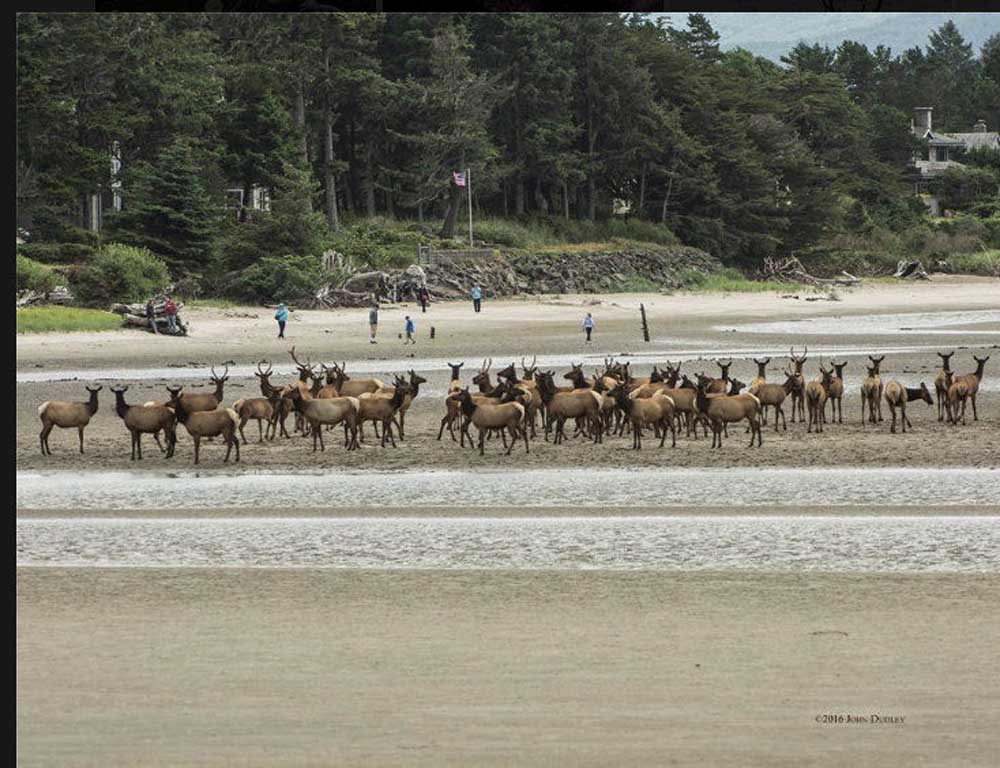‘Animal versus animal’ as elk, dogs clash
Published 4:25 am Tuesday, July 19, 2016

- Deer can travel in herds of up to 60 or more.
GEARHART — A pet whippet was trampled and killed by a herd of elk at the Reserve at Gearhart this month. In another incident reported to Gearhart Police, an elk kicked a dog and broke the dog’s legs. A Little Beach resident said he saw a herd menace kayakers this month when they approached too close to the shore.
“They will sometimes get aggressive,” Wildlife Communications Coordinator Michelle Dennehy of the Oregon Department of Fish and Wildlife said. “It can happen anytime. The advice for pets and people is to try to keep away.”
Oregon has two types of elk, Dennehy said, Roosevelt elk on the coast and Rocky Mountain elk in the Cascades. Roosevelt elk bulls typically weigh 900 pounds, and cows clear 600 pounds. Roosevelt elk in western Oregon have the larger body size, but typically Rocky Mountain elk — prevalent in Eastern Oregon — have larger antlers. “This makes sense when you think about how Roosevelt elk need to get through very thick brush,” she said.
With calving season, people and their pets are well-advised to steer clear of the herd, she said, which can reach 60 or more.
A sign posted by the dunes in Gearhart warns: “Keep clear of the elk. Elk will charge to defend calves.”
Gearhart Police Chief Jeff Bowman said the risk increases at a time when elk cows are protective of newborn calves. “It all boils down to an animal versus animal, and the elk aren’t going to back down from a dog coming at them. They’ve got babies. If people are walking and not having their dogs on a leash, they’d better be looking for the elk.”
Everywhere there are elk, “people should have their dogs on leash,” naturalist and photographer Neal Maine said. “A modern-day dog really doesn’t understand an elk, and most people think the elk are going to run away from a dog. Elk can chase them, much like people take their dogs to the beach to chase birds around for exercise. Coyotes and wolves are two of their past enemies, so they’re all set up to take them out.”
The behavior may be brutal. Once they get a dog down, “they pound on them with their feet,” Maine said. “It’s part of their reaction to a predator.”
“If your dog is cornered — you wouldn’t want to intervene, unless you’re really foolhardy,” Maine added.
John Dudley has a home by Little Beach in Gearhart, ground zero for the elk population, where he chronicles the path of the elk with his camera. “The difference lately has been there have been calves in the herd, week-old calves,” Dudley said. “It’s postpartum time for the cows.”
One “alpha bull,” recognizable by a small but visible scar on his right shoulder, in the herd is particularly aggressive, Dudley said.
Sometimes the bull becomes “rather agitated,” herding the others, corralling them, and fighting off young bulls who consider themselves “pretenders to the throne.”
Dudley said he witnessed an encounter when a kayaker in the estuary was pulled toward the shore by the tide. The kayakers drifted closer to the herd and they pulled out cellphones to film the encounter.
“Suddenly something spooked the elk and en masse they galloped south,” Dudley said. “They could have just as easily stampeded over the kayakers.”
Normally, Gearhart’s elk herd “kind of moseys,” Bowman said.
Hikers and visitors should take heed when “their heads come up from their feeding and they’re staring at you and they’re not turning,” he said. “Turn around and go back,” Bowman said. “They’ll leave you alone. They aren’t going to chase you down. Their heads are going to go back down and they’ll continue eating.”
Elk eat 50 pounds a day — “and they don’t care if it’s your garden, off the golf course or through the woods,” Bowman said.
People should not attempt to approach the elk for cellphone pictures. “If they want to do photography, get a camera,” Maine said. “Elk photography with a cellphone is not productive.”
“The two times I’ve seen chase-downs, they’d been trying to get close enough to get a cellphone shot,” Maine said.
Maine advised the best way to enjoy the elk is to appreciate “an amazing creature that’s been here for thousands of years.”
“We should learn to become observers of wildlife, he said, and take 15 minutes to watch the interaction between the cows and the calves and the spikes,” Maine said. “Keep your distance and watch the phenomena of them moving, feeding, interacting, so you’re observing something, not just trying to get a picture. Watch their behavior and be intrigued and interested in that part of it. That gets missed by the drive-by folks.”
Prior to European settlement, more than 10 million elk roamed nearly all of the United States and parts of Canada, with about 1 million today.
Maine said at one point, less than a century ago, the elk were virtually extinct in Clatsop County from overhunting. Hunting was closed for about 10 years as elk were reintroduced into the area. “There are people who say their grandpa had a picture of elk being unloaded from a train in downtown Seaside to transplant here.”
To stay safe, keep your dog on a leash, no elk selfies and observe, don’t interfere, Maine said. “The reason this area is so rich and so beautiful and so wonderful is because there’s still wildlife in the habitat. So observe it, enjoy it and have it make your day richer.”


